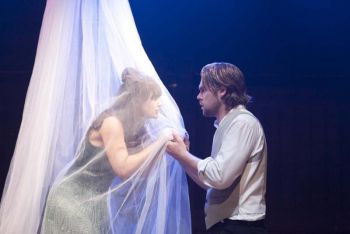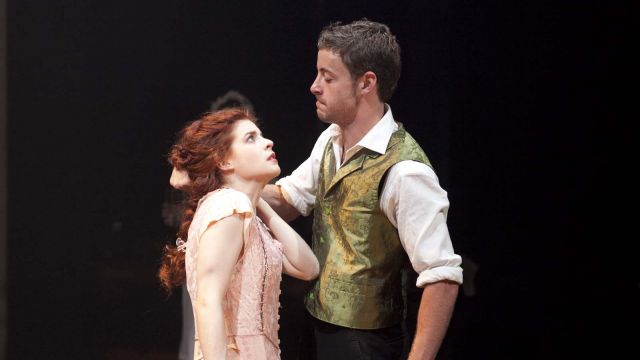Great Expectations
Commissioned by The Royal Shakespeare Company in 2005, this adaptation by Nick Ormerod and Declan Donnellan maintains Dickens’ use of the first person and transforms the novel into a piece of true epic theatre. This sits well in the hands of director John Harrison who is deft at managing large casts and has approached the production with a Brechtian-style vision.
In misty smoke haze, a rush of black and white clad actors carrying suitcases stride around a timber rake where young Pip (Callum McManis) sits on a raised dais. Through a cunningly concealed trapdoor he ushers his older self (Patrick Sherwood) and Estella (Shannon Ashlyn) to the stage. Past and future are interconnected and the cast begin their story telling. The pace is fast, but the voices so clear and the action directed so carefully to the audience, that not a word is missed.
 Suitcases become headstones. The story tellers freeze and watch as young Pip muses by his parents’ graves. In a mighty rush of chains Magwitch (Daniel Hunter) rolls and stumbles down the rake to land at Pip’s feet. This is just one example of the clever use of the rake – and the innovative use of suitcases to set a scene or inform the action. Held open by the cast, they become a kitchen dresser or a drinks cabinet or a wash bowl.
Suitcases become headstones. The story tellers freeze and watch as young Pip muses by his parents’ graves. In a mighty rush of chains Magwitch (Daniel Hunter) rolls and stumbles down the rake to land at Pip’s feet. This is just one example of the clever use of the rake – and the innovative use of suitcases to set a scene or inform the action. Held open by the cast, they become a kitchen dresser or a drinks cabinet or a wash bowl.
As Pumblechook (played with appropriate bumbling, self important hesitancy by Alan Dearth) leaves young Pip at Satis House, Miss Havisham (Jacki Mison) appears from the rake, trapped under a symbolic tulle canopy through which she captures Pip’s imagination and watches constantly. It is here too that Pip encounters the artful lawyer, Jaggers (Jim McCrudden), who is to bring so much change to his life.
This is probably giving too much of Harrison’s creative vision away, but it’s important to establish that he has used the techniques of epic theatre so well to bring this clever adaptation to the stage. While Omerod and Donnellan use Dickens’ words to tell the story and make the transitions, it is Harrison’s wide theatrical experience as both actor and director that brings the adaptation to vibrant life.
 He keeps the pace constant yet direction is intricate. Cast members move swiftly, smoothly, seemingly effortlessly from character to story teller, at the same time moving quickly in carefully directed paths to set situations or re-establish scenes. One minute we are in Pip’s London rooms, in the next the eerie waters of the Thames. The ensemble work is impressive, the energy and enthusiasm of the cast almost palpable. Yet this does not appear to tire them – or the audience.
He keeps the pace constant yet direction is intricate. Cast members move swiftly, smoothly, seemingly effortlessly from character to story teller, at the same time moving quickly in carefully directed paths to set situations or re-establish scenes. One minute we are in Pip’s London rooms, in the next the eerie waters of the Thames. The ensemble work is impressive, the energy and enthusiasm of the cast almost palpable. Yet this does not appear to tire them – or the audience.
Whilst some actors, as indicated above, play the key roles that link Pip’s story, others take on a variety of roles. Of these, Kieran Foster is hatefully nasty as Orlick and Jarrod Crellin endearingly lovable as Joe. It was interesting twist to use the same actor (Richard Hillier) to portray Miss Havisham’s jilting suitor and Estella’s oily husband. But all the cast, as they take on their multiple roles and stage management tasks, are in the moment constantly. They watch the action – and react to it meaningfully. Then they are on the move – taking the audience to the next scene, the next instalment – just as the original story went to its audience, only much more quickly!
bAKEHOUSE, Harrison, and his cast have brought a fine production to the atyp stage – one which does Dickens and his characters proud!
Carol Wimmer
Photographer: Ross Langley.
Subscribe to our E-Newsletter, buy our latest print edition or find a Performing Arts book at Book Nook.

